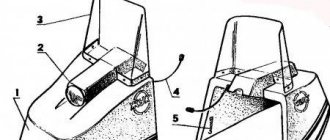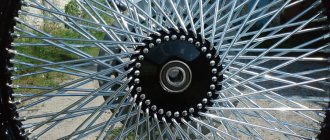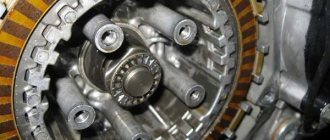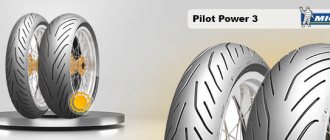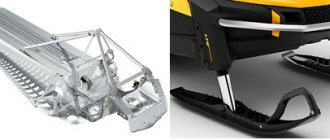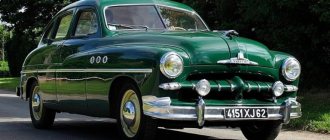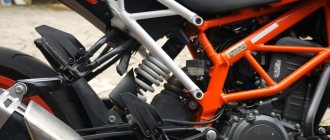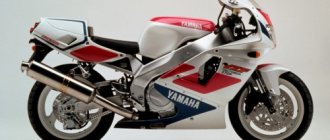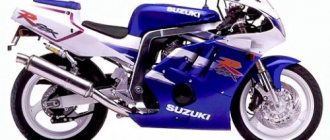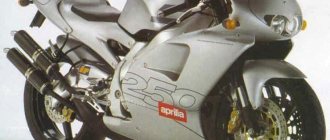Hello.
I came across an excellent article on motorcycle suspensions on the English-language Internet, I am posting its translation, since the information is presented simply, clearly and quite completely. The article is almost popular science, I don’t recommend it to hard-boiled theorists, but for those who want to understand the types of motorcycle suspensions without delving deeply into the details, it will be very useful. In fact, the most useful information for the average user has been collected.
Yes, and for owners of BMW motorcycles, this article will be of particular interest, since it has an entire paragraph devoted to the types of suspensions for motorcycles of this brand.
Background.
Suspension options for motorcycles are as varied as those for cars. Of course, the motorcycle only has two wheels, but this forces engineers to pay closer attention to the suspension. The most common type of motorcycle rear suspension is a swingarm with two shock absorbers or a swingarm with one shock absorber (monoshock). The most common front suspension option is a telescopic fork. Although, oddly enough, cruiser-style motorcycles that have no rear suspension at all are still common - the so-called “hardtail” (“dry frame” or “cracker”). In this case, the rear wheel axle passes through the frame. This is a kind of tribute to history, because until the 20s of the last century, the only thing that was between the road and the rider’s ass were the springs under the saddle and the tire pressure.
Story
Front suspension
It's hard to imagine, but the first motorcycles were equipped with springs, which were used to soften shocks when driving over uneven surfaces. They were attached to the steering column using a long tube that split at the end like a rigid bicycle fork. However, this design of the motorcycle suspension quickly showed its inconsistency, since it required frequent maintenance, and also did not dampen vibrations well and did not allow for good handling.
Therefore, already in the 20s of the last century, a parallelogram fork replaced the primitive spring suspension. In it, two rigid racks, united by a cross member and a triangular strut, are connected to the motorcycle handlebars using swing arms. In addition, a spring is attached to the central point of the steering column, which rests with its opposite end against the cross member of the parallelogram fork, while the shock absorber is slightly offset to the side. The advantage of this suspension design was greater rigidity, which helped the rider better maintain a stable trajectory, but its disadvantage was increased control inertia and low efficiency in combating vibrations.
In the 1930s, engineers from several motorcycle companies worked on lever forks, which were a suspension design with different characteristics. In it, two rigid pipes were attached to the steering column, but they were not directed towards the wheel, but were bent, following its contours, as a result of which the other end of such a fork was located not far from the frame at the same level with the axis of the front wheel. The suspension that connected the fork to the wheel consisted of long arms that ran from the end of the tubes to the axle, as well as shock absorbers. The latter were mounted on the arms near the wheel axis, and also at the point where the fork bent, deviating from a straight line emanating from the steering column. This suspension design improved handling and comfort, but at the cost of a limited steering angle, as well as an increased wear rate of its components.
Lever front suspension was used on many heavy motorcycles, including Soviet Urals. It was improved in the 70s by Harley Davidson engineers - they took a parallelogram fork, but made it closer to the vertical, as a result of which they had to connect the pipes to the wheel with a short lever. This design was called “springer” - it is used on many tuning motorcycles today. It is worth noting that even the other types of suspension listed above are often used in custom bikes, which allows them to be styled for a certain era.
Rear suspension
If the need to use a front suspension was obvious, then for a long time no one thought about damping vibrations received by the rear wheel. Therefore, until about the mid-30s, the most popular remained the so-called “hardtails,” that is, motorcycles without any rear suspension. Driver comfort was ensured by the spring-loaded seat, as well as by the natural elasticity of the pneumatic tire. However, the passenger had to use a thick soft pillow to avoid unpleasant sensations, since in those years his seat was a rigid platform connected to the frame using pipes. It is interesting that such a design without suspension is still found today - as a rule, it is used in custom bikes that are not designed for high-speed riding.
However, as the pace of movement increased, we had to take care of comfort, since a strong blow at high speed could knock the motorcyclist out of his seat, and simply disrupt the trajectory of the vehicle. Therefore, at the end of the 30s, a spark plug suspension for motorcycles was developed, which began to be widely used in production vehicles 10 years later. It uses blocks of double-sided springs that are located on both sides of the wheel and connect the frame to the axle. The advantage compared to a hardtail was at least some comfort, but the disadvantage of this suspension design was rapid wear and poor cornering control due to the lack of connection between the two sides of the rear fork. The spark plug pendant is also used only in modern custom cars, stylized as retro.
In a nutshell about the geometry of the motorcycle.
Before you plunge into the murky world of technical terms outlined in this article, it would be useful to understand the basic logic of the suspension of any motorcycle. The following illustration shows the basic terms you will encounter.
Steering Axis - control axis; Rake Angle - “rake”, fork angle; Trail - “trail”, the distance on the ground between the wheel axis and a line extended from the axis of the steering column; Wheelbase - wheelbase, the distance between the axles of the front and rear wheels of a motorcycle.
Sportbikes have a small rake, which means the trail is also not great. A small trail gives less stability and stability, but it makes the motorcycle more easy to control and maneuverable. On the contrary, choppers, cruisers and customs have a large rake. More rake means more trail, which makes such motorcycles stable and stable in a straight line, but they are difficult to steer. Typically on motorcycles the rake fluctuates between 5 degrees. For example, the Yamaha R1 sportbike has a fork angle of 24 degrees, while the BMW K1200LT cruiser has a fork angle of 26.8 degrees.
General conclusion
To get a first impression of a motorcycle’s behavior on the road, it’s enough to evaluate its geometry, length and suspension offsets. Short bikes with a modest front fork angle will be easy to maneuver, but are likely to be extremely unstable and prone to bouts of wobbling. Most likely, such models will even have to be classified as aggressive if their engine has more power.
When in front of you is a motorcycle with a long wheelbase, in the city these are elongated forks, simply an elongated shape and, less often, a long pendulum, you can imagine how stubborn your unit will be when cornering, it will become difficult to corner sharp corners, but the stability will be excellent.
These bits of quick inspection will already be enough to understand how to start an introductory motorcycle ride. Because it’s up to you to choose the speed based on the responsiveness of the equipment in maneuvering. Especially when it comes to heavy traffic.
Source
Hello everyone, my name is Alexander, I decided to share my so-called creations on this site.
Not long ago I bought Voskhod 2, this is a Soviet miracle of technology motorcycle, and started pumping it up!
I quote from the personal VK group - https://vk.com/gga64
Since when I bought it, I knew that it wouldn’t start, so I bought it in the village from the boys, and everything is clear there. I exchanged it for a vape, which I bought for 1,400 rubles (the average price is higher), but I will still keep track of the funds spent on the project.
I successfully brought it home, washed it and began to disassemble it down to the screw.
First of all, I took it apart, a rather interesting procedure, since before I had not been involved with Soviet motorcycles except for the Carpathians.
The second, and most interesting thing, is its heart of a single-cylinder, everyone’s favorite engine on splined bolts))) I took this miracle apart for an interesting time, since unscrewing a licked spline groove in the depths is not very easy!) Then I set about completely disassembling the engine and finding out the problems and shortcomings . The box will still live, but I didn’t tell myself exactly. Everything there was too worn out, and the head cover gasket was jammed, well, they installed it that way))) because of this, there was no compression, unfortunately there are no photos. all the bearings were rusty due to the fact that the motorcycle was standing on the street through the hole in the plug, oil was poured into it normally. there was almost no oil there, 60% was occupied by fuel oil and stone that had already become coked over many years there. This was due to the fact that instead of normal oil they poured whatever happened and it just went on like that)
Plunging when braking.
One of the drawbacks of telescopic forks is their tendency to compress when braking, causing the bike to nose-dive. Such bites depend most on the geometry of a particular motorcycle. When you brake, you slow the motorcycle forward. The force of inertia goes somewhere, and that “somewhere” is the front fork. Because the telescopic fork is at an angle to the vertical axis of the motorcycle and at an angle to the force vector pushing the motorcycle forward, some of that force compresses the suspension. Let's remember the school physics course. The force transmitted at an angle is equal to the main force multiplied by the cosine of the angle. Remember that the rake angle is calculated from the vertical axis? Therefore, the angle we are talking about is actually equal to the difference between 90° and the angle of the staff, that is, it is an additional angle to the staff. And since sine and cosine are mutually inverse functions, the cosine of the rake will be equal to the sine of the complementary angle. So for a rake of 25° degrees, we can use both the sine of the additional angle (65°) and the sine of the rake.
Look at the picture on the right and imagine that the rake of our motorcycle is 25°. Then the force that acts on the front fork of the motorcycle will be equal to the breaking force multiplied by the sine of the rake angle. For clarity, let's take a ridiculously small braking force of 1 Newton. Then our calculation will look like this: 1*sin(25)=0.4226 or 42.26%. That is, 42% of the braking force is distributed to the fork and puts pressure on the springs and oil. Now let's plug in the real numbers. Let's imagine that your weight is 100 kg, and the motorcycle weighs 165 kg. Braking force = mass*acceleration. By pressing the brake, you can easily achieve a deceleration of 1G, that is, 9 m/s?. In this case, the braking force is: 265 kg * 9 m/s? = 2385 newtons. If 42% of this force is applied to the springs and oil of the motorcycle, the fork has to cope with a force of about 1000 Newtons, which is equal to 100 kg. weight. It's like you're putting your entire body weight on the fork of the motorcycle - that's why we feel the dive.
The first shot in the war against dives was fired by the Honda concern, when in 1969 the engineers of this company developed the TRAC (Torque Reactive Anti-Dive Control) system, but it was used in the design of individual motorcycles until the 80s of the last century. In those days, the front fork hydraulics of a motorcycle interacted with the brake hydraulics and is best remembered for the Kawasaki GPZ900R, whose anti-dive system was called AVDS (Automatic Variable Damping System).
AVDS consisted of an additional hydraulic cylinder located at the bottom of each fork leg and connected to the calipers. The idea was to use the brake fluid pressure generated in the calipers to close the fork oil valve via a plunger, thereby increasing fork stiffness. A stiffer suspension reduced dive.
It sounded good, but many people disliked this system for one feature of the motorcycle’s behavior on bad roads. When braking on a rough road, riding a motorcycle was more like falling down a flight of stairs, since all the unevenness of the road was transmitted through the rigid fork to the motorcycle frame and, of course, to the rider. This also created an increased load on the motorcycle fork seals, which led to the need for their frequent replacement. Since then, these childhood diseases have been eliminated, and the developments of those years are often used in the design of forks of modern motorcycles.
TRAC.
Honda's TRAC system was somewhat different from Kawasaki's AVDS. According to Honda, hydraulic systems have two main disadvantages. Firstly, the additional hydraulic line gave the brakes a “wet” effect. Secondly, such systems are interdependent on each other. So Honda engineers decided that their system should be actuated by rotating the brake caliper itself. This made the system completely independent of the brake circuit. The brake calipers were not rigidly fixed to the feathers, but were located on movable brackets. When you press the brake, the friction force that arises between the brake pads and brake discs moves the calipers, the caliper presses on the anti-dive system valve installed directly in the motorcycle's seatstays. The Yamaha and Suzuki systems worked in approximately the same way, but the Honda system differed favorably from its competitors in that it worked tolerably on rough roads. The thing is that the TRAC system valve was floating and held in place by a spring. Thus, when hitting a bump, the oil had time to fill the space behind the valve, which actually turned off the system. Smart, right?
MY MOTORCYCLE
A lever fork is one of the main attributes of any stroller, and certainly a shit climber can’t do without it. For example, in the West, people generally cannot imagine a motorcycle with a sidecar equipped with a telescopic fork - for them the lever is the first gadget that needs to be installed on the sidecar alone.
Of course, I’m not a designer, and I don’t have any special knowledge. This article is written from the perspective of an ordinary person, and may contain many erroneous ideas. The “drawings” given here are also probably not drawn very correctly, but if anyone is interested, then in the future I can post a 3D model of the product in 3dm Rhinoceros format. I’ll say right away that the fork was originally made with a very critical error, as a result of which it broke at the most inopportune moment. This led to an accident, but fortunately no one was injured. I'll talk about this at the very end of the article.
So, making a lever fork is the easiest way to get a durable, long-travel motorcycle fork. However, despite the apparent simplicity of its design, I personally encountered unexpected difficulties, which, however, I was able to overcome after understanding their cause.
A friend gave me 2 ready-made feathers and a pendulum blank, and I started from these details when developing my product.
My tasks were as follows:
- Increase ride comfort over uneven surfaces;
- Raise the front of the motorcycle as much as possible. This was required to increase clearance;
- Reduce the overhang (trail) to the minimum acceptable value in order to facilitate steering both on bad roads and on asphalt;
Based on these tasks, using CAD, I quickly made a model of the fork along with the motorcycle frame, checked everything, and made a swingarm from a round pipe. But this pendulum did not satisfy me with its low rigidity, so I threw it away. I had to redraw the project and weld a new pendulum from a St-3 25x40x2 profile pipe. This pendulum turned out to be very rigid. The only place in it that requires explanation is the bushings for the wheel axle. The bushings are solid, steel, and the axle is simply passed through them and secured with a nut. The wheel and brake drum are secured against axial displacement by a spacer sleeve. The axle play is eliminated using brass bushings that I made from 12 gauge brass sleeve.
I assembled the pendulum in a certain order. First the end tubular sections were cut out, then I welded the bushings to them. After this, the welding points between the bushings and the pendulum were reinforced with side plates, welded in a circle. Then, having threaded the axle through the bushings, I welded the main sections of the pendulum to the end sections. The next step is welding the shock absorber mounting ears. In the end, I realized that it was easier to install the ears on a fully assembled swingarm, and welded the rear bridge to it. It was then that I encountered the problem of the product moving away during welding, but I easily straightened the bent pendulum using a jack. Then I installed reinforcing pads under the ears for attaching the feathers, and then the ears themselves. Next, it remained to install the gussets on the connections of the pendulum jumper, and I did this, spreading its ends with a jack so that it would not move away. All ears should be welded by passing a pin through them to control the location of all parts; It is convenient to measure the size from the inserted wheel axle.
Next, I installed the upper shock absorber mounting lugs on the stays, and my fork, in general terms, was ready for fitting. I decided to install silent blocks in the bushings of the feathers, but I couldn’t find anything suitable in auto stores. Silents had to be made from scrap materials: the rubber bushing of the passenger footrest was ideal, and steel bushings with an internal diameter of 12 mm were found on the farm. The wheel axle was made from the rear wheel axle, the “thick” part of which had to be ground 30mm so that the long narrow part, 20mm in diameter, would fit through both bushings.
Now I must say a few words about shock absorbers. Initially, I lengthened the standard Ural shock absorbers, and replaced the “native” mount with a silent block. A silent block on a tube leg was attached to the body by welding. I will not describe all my torment associated with selecting the optimal shock absorber length, but I will say right away that it is now 370mm. Subsequently, on one of these ancient KMZ products, my stem broke, and I replaced them with a Chinese analogue. I also welded tubes for silent blocks onto their lower mount. A little more time passed, and I replaced the Chinese dinners made from someone’s feces with old Soviet ones. From that moment on, everything became good, and I have been driving these shock absorbers for a year now without any problems.
The reaction rod of the brake shield is attached to the pendulum. On the one hand, this solution seems good to me, since it does not require any additional tricks. Usually the rod is attached to the feather, and this necessitates allowing the shield to swing relative to the pendulum. In my case, the shield always remains motionless and can be tightly clamped between the bushings of the pendulum and the hub. In general, the anti-dive of the fork is regulated by the location where the torque rod is attached. In my case, when braking, the motorcycle not only doesn’t bite, but on the contrary, it lifts its nose. That is, the force stretching the fork is too strong for me. But since I use standard, very sluggish brakes, I’m not worried about the health of the suspension. In practice, I have never experienced any “reverse breakdowns” in shock absorbers. If you attach the reaction rod a little higher, on the feather, you can ensure that the motorcycle does not receive any trim at all when braking.
So, I installed the entire structure on the motorcycle, figured out how the wing would be attached, and welded the corresponding ears to the feathers. Now the tests could begin.
At low speeds on a dirt road, the motorcycle behaved just fine, but as soon as I accelerated, I lost all control over the car, I began to wobble from side to side, as a result of which I almost rolled over. Obviously, this is how problems with the geometry of the fork manifested themselves, namely, with its offset, or trail. Through various observations, measurements, modeling and experiments, I realized that too weak shock absorber springs, as well as unadjusted rebound valves, were to blame. At low speeds, the shock absorbers at least managed to work out all the irregularities and return to their original state, but as the speed increased, they no longer coped with their job and were constantly in a semi-compressed state.
The fact is that a lever fork with a geometry like mine, when the pendulum rises on uneven surfaces, tends to greatly reduce the reach. With strong compression of the shock absorbers, it decreases to almost zero, and sometimes can reach negative values. Naturally, this causes loss of control of the motorcycle at high speed.
I solved the problem simply. It turned out to be sufficient to adjust the shock absorber valves and increase the spring preload to increase their stiffness. I tightened the springs by 15mm, placing spacer rings under them. 15mm was taken based on the fact that the shock absorbers sagged exactly by this amount when I sat on the motorcycle tank.
As I wrote above, this improvement led to a break in the rod of one of the shock absorbers: old Soviet shock absorbers, in fact, are almost impossible to adjust. They were replaced by the Chinese with good Soviet springs and the same spacer rings.
Not knowing grief, I traveled all winter, and then, in the spring, we went to the Smolensk region. It was then that trouble happened to us. On a very rough road, both forks broke, causing the motorcycle to overturn. At first we didn’t quite understand what had happened, since the fork did not fall apart, but after driving another 500 meters and flying into a ditch, we realized that something was wrong here.
And indeed, an autopsy showed that both “crowbars” were cracked along the groove that was made so that they would fit into the cross beams. The cause of the breakdown was obvious. A sharp step between two diameters served as a stress concentrator. Due to constant vibration and stress, mainly aimed at “bending” the feathers, cracks appeared on their back side. The chainstays straightened out, the trail became negative, and the motorcycle lost control.
All this could have been avoided if the transition from one diameter to another had been smooth. But ideally, cuttings were also needed, which would relieve the feathers. The broken fork was promptly welded, I also welded these same cuts from the fittings. After that, she traveled another thousand kilometers, and upon returning home, I immediately rushed to my friend, who helped me make this fork, to make new powerful feathers.
To make a completely indestructible fork, we welded feathers from “crowbars” from a standard Soviet “telescope”. One lever pen requires one and a half telescopic crowbars. They are connected using bushes secured with electric rivets. Next, the connection is scalded. We retained the original geometry. The difference with the old feathers was the absence of any grooves and the presence of bevels made from pipes. Since the lower traverse is located inside the resulting diamond, it is not removable. That is, the fork can no longer be completely disassembled - the lower yoke is movable, but it will remain with the fork forever.
After this improvement, any problems disappeared, and since then I have been driving without fear.
Source: www.sevprostor.ru
Steering dampers.
As already mentioned, with small fork rake values, the motorcycle steers easily and quickly, but suffers from a lack of stability at low speeds. This isn't much of an issue on sportbikes, which require precise handling while still being quite fast. The problems start when you hit a big enough bump. The motorcycle fork compresses, the wheelbase decreases, the motorcycle loses stability, and the front wheel dances from side to side. And so on until the fork unclenches and the wheelbase returns to its original length.
Once this happens, the gyroscopic effect that occurs on the front wheel causes the motorcycle to "bob its head." The gyroscopic effect causes the motorcycle's front wheel to wobble from side to side. In some cases, the handlebars dangle so much that the grips touch the motorcycle’s gas tank. Usually this all ends in a highside, when the motorcycle throws the rider forward, over itself.
At one time, this behavior of the motorcycle was the reason for the recall of a batch of Suzuki TL 1000S after a couple of weeks after they hit the windows of motorcycle dealerships. And this is the same reason that led engineers to develop steering dampers for motorcycles. A steering damper is a great thing to use on the track and if you don't fully trust your motorcycle. There are two main types of steering dampers: linear and rotary. Linear dampers consist of a hydraulic cylinder and a rod with a piston, one side is attached to the motorcycle handlebar, the other is attached to the frame. Such dampers are similar in appearance to shock absorbers and are not activated during normal driving, but as soon as the shock begins, the damper takes on most of the load.
Rotor steering dampers are also available. They are mounted on the motorcycle steering column above the bearing and work by increasing the steering column's resistance to sudden left-right movements. The resistance is achieved by damper hydraulics. Just try hitting one of the handlebars with your fist when the steering damper is installed - and you will understand how it works.
Motorcycles Ural and Dnepr
Sections
New on the Forum
This is where the HUD lies. I’m even going to move mine to the Dnieper frame. Whatever wonderful pendulum was closed drove it from behind and that’s it.
I don't understand. Which X (X) should I use to make a new pendulum (from scratch)? Well, if you’re working on something like “War 5000,” then it’s understandable, but if not, then.
Chew your ass off with options. This has already been discussed.
for qqq
: How is it possible without a hole in the cardan? It turns out that the swing axis of the pendulum is not on the same plane as the cardan. And then there will be a problem that the cardan will jump out or, on the contrary, it will put pressure on it (clamped when the suspension is working. Where was the cardan? On top or bottom of the pendulum. Previously, bearings for the pendulum were discussed. It was said that there are those that will fit into the bushings on the frame, but they need to be special order somewhere from a factory in Russia. But have you installed any common bearings that can be found everywhere or that are used in some kind of equipment?
Of course, there is a limit to how much the cardan can shift in these two ways, since it rotates in the hole and will eventually hit the right side of the hole. These were all ways to fit a wheel into a standard pendulum. If anyone else can offer something, then by all means let him do it.
Well, velldr, I respected you. I’ll get down to it and discuss it, but for now I’m mostly stocking up on information.
Holy shit, miracle workers. Please note that an aluminum pipe is pressed into the crankcase under the front stud. When the engine vibrates (these are just necessary vibrations, otherwise the Ural is not the Ural after all), poorly placed slabs will thresh this joint. When your thread starts to leak oil. Just standard bushings rest against the crankcase, and not against the tube and in the plane. (I've already encountered this kind of bullshit)
cool pendulums. In our case, we will have to figure out how to open the pipe to the axis of rotation of the pendulum (so that the cardan does not intersect when moving from TDC to BDC) and at the same time maintain torsional rigidity. My idea is ready, but drawing in all sorts of graphic editors is difficult.
Do it like on Voyage-Wolf. Those. The connecting pipe must be curved.
The motorcycle suspension is front fork.
Structurally, telescopic forks of modern motorcycles are an evolution of the lever fork - the so-called “Girder” fork. Girder was one of the first attempts to improve motorcycle fork control, but it had one serious drawback: when hitting a bump, the motorcycle's wheelbase decreased, which led to a loss of stability. This drawback haunts various designs of motorcycle front suspensions even now, so you have a chance to catch a wobble even on a modern motorcycle. An article on the front suspensions will appear soon, but for now let’s move on to the rear ones.
Through progress
Don't think that modern motorcycle suspension designs are perfect - they have many shortcomings that are caused by the use of compromise solutions. Due to this, engineers from many large companies are working towards developing a fundamentally different motorcycle suspension. So, a couple of years ago a comfortable and easy-to-control air suspension was introduced, but so far it has not been possible to solve the problems associated with its reliability - too much dust and dirt gets into the cylinders. In addition, many engineers are trying to adapt the automotive double wishbone suspension, which has almost ideal kinematics. However, the only relatively successful example in which this idea was realized is the super-heavy Dodge Tomahawk with a cost measured in millions of dollars.
Motorcycle rear suspension.
Two shock absorbers, a regular pendulum.
A motorcycle suspension option that has become a classic. An H-shaped swingarm attached at one end to the motorcycle frame; shock absorbers with springs are attached directly to the swingarm. That's all you could hope for when purchasing almost any motorcycle over the years of its evolution. This type of suspension began to be pushed aside by other types only in the 80s, when high-strength materials became available, which made it possible to switch to a different rear suspension geometry. But this slightly outdated design is still found on many modern motorcycles. The downside of this suspension is its flexibility during extreme driving. This drawback can only be eliminated by increasing the rigidity of the entire structure, therefore, increasing the unsprung mass, which interferes with the full operation of the suspension.
Monoshock absorber, old design, regular swingarm.
The first monoshock suspension system appeared on racing motorcycles in 1977. In fact, as experiments, this type of suspension has appeared and disappeared since the 1930s, but only went into mass production in the early 1980s.
The authorship of the term “monoshock absorber” itself belongs to Yamaha (Honda, for example, used the term “Pro Link”). The main advantage was the ability to reduce the weight of the motorcycle by restructuring the geometry of the rear suspension of the motorcycle and eliminating one of the shock absorbers. The shock absorber itself was still attached directly to the pendulum, but was located in the center, almost horizontally.
Monoshock absorber, new design, regular swingarm.
The new design of the rear suspension provided for mounting the monoshock absorber not directly to the pendulum, but through a system of connections.
Progression was added to the design, and the shock absorber itself began to be positioned more vertically, which had a positive effect on its functions, and the “cage” of a complex design was replaced with a conventional H-shaped pendulum. To develop this design, engineers only needed a little more welding and stronger material.
Monoshock absorber, pendulum with cantilever mounting of the rear wheel.
The pinnacle of evolution of motorcycle rear suspensions today is a monoshock absorber with a cantilever swingarm. This is a super light and super rigid design, which is used, for example, on the Honda VFR800.
The main advantage of this design is the ability to quickly replace the rear wheel of a motorcycle. This benefit isn't as noticeable if you only ride your bike on the weekends, but Moto-GP racing team mechanics appreciate the time savings this procedure provides. The cantilever pendulum must be made of high-strength materials and have a proven design, since the entire load falls on one single arm. If classical pendulums must mainly withstand bending loads, then a cantilever pendulum must also withstand torsional loads. That is why pendulums of this design are quite massive in shape and have several stiffening ribs.
Respectindustry › Blog › Mono-pendulum: you can’t buy it, you can’t make it
We share our experience on installing a wide rear wheel on a sportbike.
Muscle RR is a custom project based on the Honda CBR. Technically, it was implemented and tested at the end of last season and, waiting for spring and a few missing accessories, it spent almost the entire winter in our warm workshop. The delivery of the “bows” to decorate our “cake” came earlier than spring, reminding us that the new motorcycle season was approaching and that we had a grandiose project about which we had told almost nothing. Taking this opportunity, I would like to reveal to you the truth about how and why a unique cantilever swingarm was developed, manufactured and installed on the motorcycle, which became a key aspect of the transformation of the CBR into the Muscle RR.
It all started with the idea of installing a wide rear wheel on a sportbike. The idea was to build a motorcycle, of which there are practically none in our country - the concept of “custom bike” in Ukraine is often associated with choppers, bobbers, cafe racers... However, throughout the world, sportbikes occupy a significant share of the total number “pumped up” motorcycles. This means that there are ready-made solutions for carrying out such an operation as widening the rear of the bike. And most often these are the solutions that tuners all over the world use. You find a trading platform on the Internet, choose the swingarm you like for your motorcycle, buy it, and after waiting, install it. However, when ordering parts from specialized manufacturers (Roaring Toyz, Fat300customs, Chaos, TOCC and others), there may be pitfalls that complicate and increase the cost of the purchase. Not to mention marketplaces like e-Bay.
This decision did not suit us. Firstly, because when building the motorcycle we were faced with the task of saving money, but not cheapening it. Secondly, because the quality of the parts available on the market, judging by the photos and our experience, is far from ideal and requires mandatory adjustment, despite the manufacturers’ claims about problem-free installation. And finally, at some point, while thinking about how to solve our complex problem, a solution was born: install a car disk on the CBR! This idea was good from all sides: the aftermarket for cars is much wider, and therefore there is more choice and prices are more affordable. In addition, installing a car rim eliminated the need to purchase a front motorcycle wheel; instead, we decided to match the rear design to the factory front rim. Everything is within the framework of the concept of “saving, but not cheapening”.
The motorcycle owner really liked the idea of using a car wheel, especially when we suggested using a disc like the Plymouth Satellite R - its design goes well with the CBR front disc. A forged five-spoke Weld wheel 10.5x18 inches with a wide polished “shelf” cost the customer $870, while a motorcycle wheel, excluding the cost of delivery to Ukraine, is estimated on average at about 1,350 conventional units.
The choice in favor of a car wheel, among other things, determined the choice of a pendulum, since a car wheel on a bike can only be mounted on a cantilever pendulum. Such a “perversion” in terms of pendulums is widespread among Italian motorcycle manufacturers (Ducati, Moto Guzzi, MV Agusta), who have successfully used this design since the 50s on a variety of motorcycle models. When it comes to technology as an art, few can compare with Italy...
Based on our goals and in order not to reinvent the wheel, we decided to use a unit from a Ducati 1098 monoswingarm, since they are available on the secondary market. This unit is good because it solves three problems at once: it is a connecting element between the pendulum and the rear wheel, it acts as a load-bearing element for attaching the brake mechanism of the rear wheel, and it also provides the ability to adjust the chain tension.
There was one more issue that needed to be resolved regarding the installation of a car wheel. The fact is that the Ducati 1098 rear disc is attached to the swingarm axle using a central nut, so to integrate the car disc we had to make a special adapter. Now you can remove the rear wheel in two ways: by unscrewing the five nuts on the adapter or, motorcycle-style, by unscrewing just one nut. Having taken hold of this motorcycle unit, we could not ignore the driven sprocket. Since the dimensions, and therefore the weight of the rear wheel, have increased significantly, the load on the engine has also increased. To compensate for the loss of power, we resorted to a simple but effective method - changing the gear ratios. By adapting the larger 52-tooth Vortex chainring to the Ducati chainring bracket, we achieved what we wanted.
Source
One shock absorber or two? Foaming of oil in shock absorbers.
In the good old days, all motorcycles had two rear shock absorbers. In the course of evolution, the design of two shock absorbers was replaced by a monoshock absorber. Question: why?
And the answer is quite simple. In a system of two shock absorbers, they are located quite close to the rear wheel. This means that the piston inside the shock absorber moves almost the same distance that the pendulum travels. Large bumps force the piston to travel a distance of 10 centimeters up and then down, which gives the effect of foaming the oil inside the shock absorbers. When the consistency of the oil begins to resemble a Frappuccino, the shock absorbers begin to handle bumps much worse.
A monoshock system involves mounting directly at the base of the swingarm. The pendulum moves up and down the same distance, but the shock absorber piston travels a much shorter distance than with a pair of shock absorbers. And modern progression systems further soften the load on the shock absorber. Thus, the monoshock absorber copes with large bumps more easily and handles small ones faster. Looking ahead, I would like to note that, reading the paragraph about BMW suspensions, you will understand why the shock absorber mount on the first Paralever was subsequently shifted to the very base of the pendulum - precisely because the original design with a mount at the rear wheel did not provide any advantages over the same suspension design with two shock absorbers.
What makes up the length of a motorcycle?
Long forks reduce the possibilities for quickly turning the steering wheel, no sharp and nimble maneuvers, only a wide handlebar and rounded trajectories. A long fork will save the motorcycle from wobbling, because it is not so easy to swing it. And by the way, the concept of “TRAIL” occupies an important position here, which we will discuss in detail in a separate article. Let me briefly remind you that this indicator is made up of the geometry of the fork angle and the position of the contact patch; the longer the fork, the larger the Trail size, therefore the motorcycle is less obedient to maneuvers.
The second way to make a motorcycle longer is to make its swingarm larger. An extended version of the cardan is rare, but the pendulum is easier to make. This is not the best solution for the city; its undoubted advantage will be the confrontation with Willie. A motorcycle simply physically cannot jump onto the rear wheel with such geometry!
The advantages of a long pendulum are known to people who practice outside of city traffic and love speed and skidding. The swingarm, as long as a freight train, makes the motorcycle stable enough to make some interesting tricks, but it’s unlikely that you’ll be able to pull them off on public roads. Although, of course, this design more than attracts attention.
